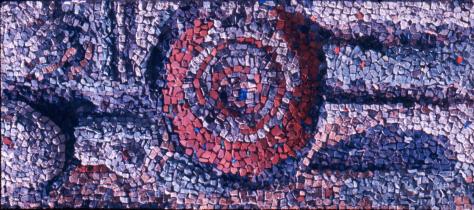Jaime Andrade was an Ecuadorian sculptor and engraver from Quito, Ecuador. Themes for his work seem to be inspired by socially conscious themes the land and sky in Ecuador, the largely poor, indigenous populations- the Andes and the tropical coastal area, as well as the Inca heritage. He uses the natural properties and colors of stone and metal to create sculptural collages and play on light and texture.
 |
| Jaime Andrade Moscoso El Arbol 21" high. The sculpture was part of the IBM collection and was exhibited at the New York World's Fair in 1940. |
In 1958 Merton commissioned Andrade to do a statue of the Virgin Mary and child Jesus in dark wood for the novitiate library. "A statue," as he explains, "that would tell the truth about God being 'born' Incarnate in the Indians of the Andes. Christ poor and despised among the disinherited of the earth." (Merton, A Search for Solitude, p. 177.)
Merton describes its imagery as "precisely that of Louis M[assignon]" Merton interpreted the mother as an indigenous Andean who reflected "a great mystery of poverty and darkness and strength" and the child as "the Resurrection to be born from the despised peoples of Mexico and the Andes" who holds a "mystical bit of fruit" that represented salvation. She represents "all that is most abject, forgotten, despised, and put aside."
"I want to say how deeply moved I am at this idea of Louis Massignons's that salvation is coming from the most afflicted and despised. This, of course, is the only idea that makes any sense in our time." (from a letter to Jacques Maritain, 17 Aug 1960)
This is a very poor scan of a not great reproduction of the Merton commissioned statue at Gethsemani. Merton took the picture, the original photograph is now at Bellarmine University in Louisville. In seeing the Mother and Child statue take place, Merton suggested that the child hold something - a branch, fruit, or root, something indigenous to South America. Definitely not corn "because of its association with bad art".


This is a wonderful post. Our Lady was so central to Merton's idea of monasticism. I believe that there is a picture of this sculpture in a book that I am having trouble recalling. Any thoughts?
ReplyDeleteI'm finding it all both fascinating and mysterious, Mark. Yes, Merton's very monastic vocation seems to rest in his devotion to Our Lady. He died before even gender sensitive language became the norm and his relationships with women theologians could be complicated. He questioned even how his "white" privilege affected his vocation and was moving away from institutional monasticism in his final years.
DeleteIf you find the photo of the Andrade sculpture, I'd love to see it.
Couldn't find a book but it is on the Merton.org homepage from Bellarmine. It could be a replica.
DeleteThanks, Mark.That's definitely a clearer photo of the statue. Interesting that this photo looks like the statue if inside, where the one that Merton took looks like it is outside. Perhaps they moved it?
DeleteThe photo on Merton.org is in the Thomas Merton center at Bellarmine University.
DeleteHmmm. THen I guess the statue is no longer at Gethsemani. Kind of a shame, in my opinion, though I guess more people will see it at Bellarmine. Just that it seems to me that sculptures are made for an environment/place and can't be "lifted" from their surroundings without losing something. I could be wrong.
DeleteI did some research and it seems that the statue was in storage at Gethsamini for years before it came to Bellarmine. Its also on loan there as opposed to the papers which are permanent. Its quite sad honestly but great that it's now displayed and enjoyed at the center.
ReplyDeleteIn Storage??!!! My gosh, how can something that beautiful and significant be put in storage?! I shutter to think of all the things that are squirreled away in attics and storage places that could be put back into the flow of life … I too am glad it's at the Bellarmine Center now. Thanks for this information, Mark. Next time I am in Louisville, I will stop by. One of my very good friends lives on the edge of the Bellarmine campus - her husband is a professor there.
Delete